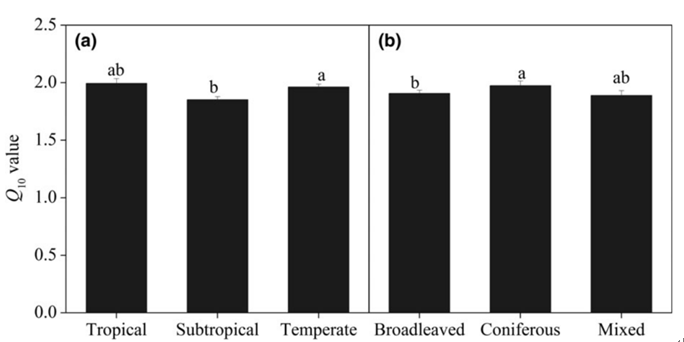
The amount of carbon dioxide (CO2) released to the atmosphere through soil microbial respiration (Rs) is estimated to be 60 petagrams of carbon. Therefore, a small change in the response of Rs to elevated temperature will have great influence on soil organic C stock and atmospheric CO2 concentration under a continuously warming scenario.
In recent years, temperature sensitivity (Q10) of Rs or soil organic carbon decomposition has gained increasing concerns. However, most previous incubation experiments on the Q10 were conducted at constant temperatures, resulting in the thermal acclimation of soil microbial community and the substantial differences in substrate availability, which greatly influence Q10 values.
Furthermore, the previous studies at large scale is used the same incubation temperature for all soils collected from different sites, resulting in a deviation in estimated Q10 values.
Thus, to advance the understanding of the spatial pattern of Q10 values and its fundamental drivers, professor WANG Qingkui and his colleagues from the Institute of Applied Ecology of the Chinese Academy of Sciences conducted a novel incubation experiment with periodically changing temperature. The experiment was based on the mean annual temperatures of soil origin sites along a 3,800 km long north–south transect of forests in eastern China.
They had three important findings in this study. First, Q10 values of Rs nonlinearly changed with latitude, showing low Q10 in subtropical forests and high Q10 in temperate forests. Second, coniferous forest soils had higher Q10 values than broadleaved forest soils, and soil carbon:nitrogen (C:N) ratio was positively related to the Q10 values, supporting the "carbon quality temperature" hypothesis. Last, the dominant factors regulating the regional variations in Q10 varied among the tropical, subtropical, and temperate forest ecosystems, although gram-negative bacteria exhibited the most importance in regulating the variation in Q10 across all ecosystems, followed by the C:N ratio, fungi, and the fungi:bacteria ratio.
Their results suggested the non-linear latitudinal patterns of Q10 values of Rs and highlighted the importance of carbon quality (C:N ratio) and microbial controls over Q10 value in China's forest ecosystems.
The results were published in a paper with the title "Carbon quality and soil microbial property control the latitudinal pattern in temperature sensitivity of soil microbial respiration across Chinese forest ecosystems" in Global Change Biology.
The work was supported by the National key R & D projects in China and the National Natural Science Foundation of China.

Average temperature sensitivity (Q10) values of soil microbial respiration for soils (a) in different climate-zone categories and (b) in broadleaved, coniferous, and coniferous-broadleaved mixed forests (Image by WANG Qingkui)

86-10-68597521 (day)
86-10-68597289 (night)

52 Sanlihe Rd., Xicheng District,
Beijing, China (100864)

